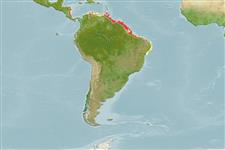Common names from other countries
Environment: milieu / climate zone / depth range / distribution range
Ökologie
seewasser; brackwasser demersal; tiefenbereich 1 - 36 m (Ref. 13608). Tropical; 16°N - 14°S, 87°W - 34°W
Western Central Atlantic: Honduras to Salvador (Bahia) in Brazil.
Length at first maturity / Size / Gewicht / Alter
Maturity: Lm 20.0 range ? - ? cm
Max length : 57.0 cm TL Männchen/unbestimmt; (Ref. 3273); common length : 35.0 cm TL Männchen/unbestimmt; (Ref. 3273); max. veröff. Gewicht: 2.3 kg (Ref. 5217)
Rückenflossenstacheln (insgesamt) : 3; Rückenflossenweichstrahlen (insgesamt) : 28 - 30; Afterflossenstacheln: 0; Afterflossenweichstrahlen: 25 - 27. Supraorbital and interorbital region smooth, without any filament; scaled area on head extending to middle of eye and opercle spine; 9 discrete pores on inner face of pectoral fin; body brown, with black spots and saddle-shaped blotches (Ref. 13608).
Mainly in brackish water (Ref. 5217). Found on sandy-muddy bottoms in shallow warm water. Not so active, lingers over the substrate disguised. Feeds on small gastropod mollusks, crustaceans like crabs (Calappidae, Portunidae, Xanthidae, etc.), shrimps (Penaeidae, Palaemonidae, Alphaeidae, etc.) and fishes. Females are mature at around 20 cm length, males at 25 cm. Spawns 400 to 500 eggs, with a size of 4 to 5 mm (Ref. 35237). Marketed fresh.
Life cycle and mating behavior
Maturities | Fortpflanzung | Spawnings | Egg(s) | Fecundities | Larven
Collette, B.B., 1978. Batrachoididae. In W. Fischer (ed.) FAO species identification sheets for fishery purposes. West Atlantic (Fishing Area 31), Volume 1. FAO, Rome. (Ref. 3273)
IUCN Rote Liste Status (Ref. 130435)
CITES (Ref. 128078)
Not Evaluated
Bedrohung für Menschen
Harmless
Nutzung durch Menschen
Fischereien: kommerziell; Aquarium: Kommerziell
Tools
Zusatzinformationen
Download XML
Internet Quellen
Estimates based on models
Preferred temperature (Ref.
115969): 27.1 - 28.3, mean 27.6 (based on 300 cells).
Phylogenetic diversity index (Ref.
82804): PD
50 = 0.5020 [Uniqueness, from 0.5 = low to 2.0 = high].
Bayesian length-weight: a=0.00776 (0.00485 - 0.01241), b=3.15 (3.01 - 3.29), in cm Total Length, based on LWR estimates for this species & (Sub)family-body (Ref.
93245).
Trophic level (Ref.
69278): 3.7 ±0.62 se; based on food items.
Widerstandsfähigkeit (Ref.
120179): niedrig, Verdopplung der Population dauert 4,5 - 14 Jahre. (Preliminary K or Fecundity.).
Fishing Vulnerability (Ref.
59153): Moderate vulnerability (43 of 100).
